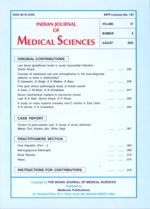
|
Indian Journal of Medical Sciences
Medknow Publications on behalf of Indian Journal of Medical Sciences Trust
ISSN: 0019-5359
EISSN: 0019-5359
Vol. 60, No. 1, 2006, pp. 3-12
|
 Bioline Code: ms06001
Bioline Code: ms06001
Full paper language: English
Document type: Research Article
Document available free of charge
|
|
|
Indian Journal of Medical Sciences, Vol. 60, No. 1, 2006, pp. 3-12
| en |
The impact of HIV/AIDS on the quality of life: A cross sectional study in north India
Wig Naveet, Lekshmi Raja, Pal Hemraj, Ahuja Vivek, Mittal ChanderMohan, Agarwal SunilKumar
Abstract
Objective:
To determine the impact of Human Deficiency Virus (HIV)/Acquired Immunodeficiency Syndrome (AIDS) on the quality of life (QOL) on such patients in North India.
Design:
A cross sectional study.
Setting:
Outpatient setting and wards, Department of Medicine at a premier tertiary health care center, North India.
Participants:
Sixty-eight consecutive HIV/AIDS patients attending Medicine out patient department and/or admitted to the wards of All India Institute of Medical Sciences were administered a structured questionnaire by the HIV nurse coordinator. QOL was evaluated using the WHOQOL-Bref (Hindi) instrument.
Analysis:
One way Analysis of Variance (ANOVA) was performed to find out significant difference between the clinical categories and socio-demographic variables on QOL domains.
Results:
The overall QOL mean score on a scale of 0-100 was found to be 25.8. Similarly, on the scale of 0-100 the mean scores in the four domains of QOL in descending order were social (80.9); psychological (27.5); physical (17.7) and environmental domain (11.65). There was a significant difference of quality of life in the physical domain between asymptomatic patients (14.6) and patients with AIDS (10.43) defining illnesses (p< 0.001) and asymptomatic and early symptomatic (12) patients (p=0.014). QOL in the psychological domain was significantly poorer in early symptomatic (12.1) (p< 0.05) and AIDS patients (12.4) (p< 0.006) as compared to asymptomatic individuals (14.2). A significant difference in QOL scores in the psychological domain was observed with respect to the educational status (p< 0.037) and income of patients (p< 0.048). Significantly better QOL scores in the physical (p< 0.040) and environmental domain (p< 0.017) were present with respect to the occupation of the patients. Patients with family support had better QOL scores in environmental domain.
Conclusions:
In our study, QOL is associated with education, income, occupation, family support and clinical categories of the patients.
Keywords
HIV, AIDS, Impact, Quality of life, WHOQOL-Bref
|
| |
© Copyright 2006 Indian Journal of Medical Sciences.
Alternative site location: http://www.indianjmedsci.org/
|
|
